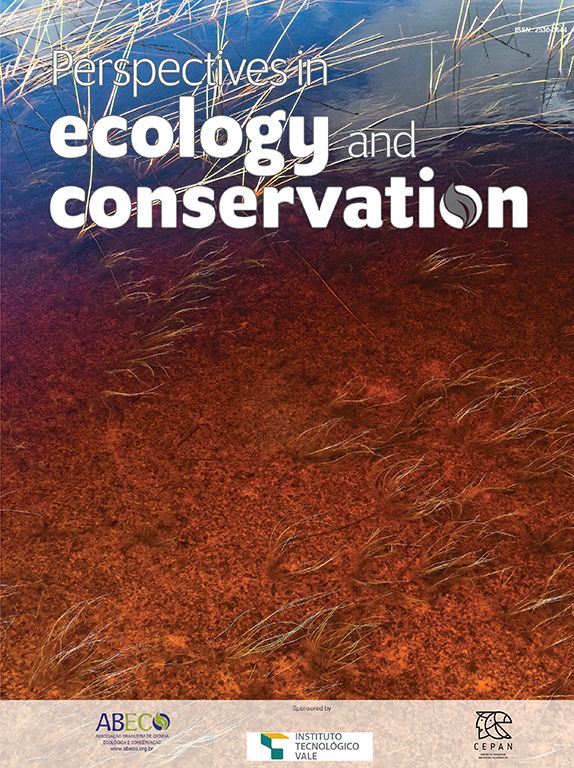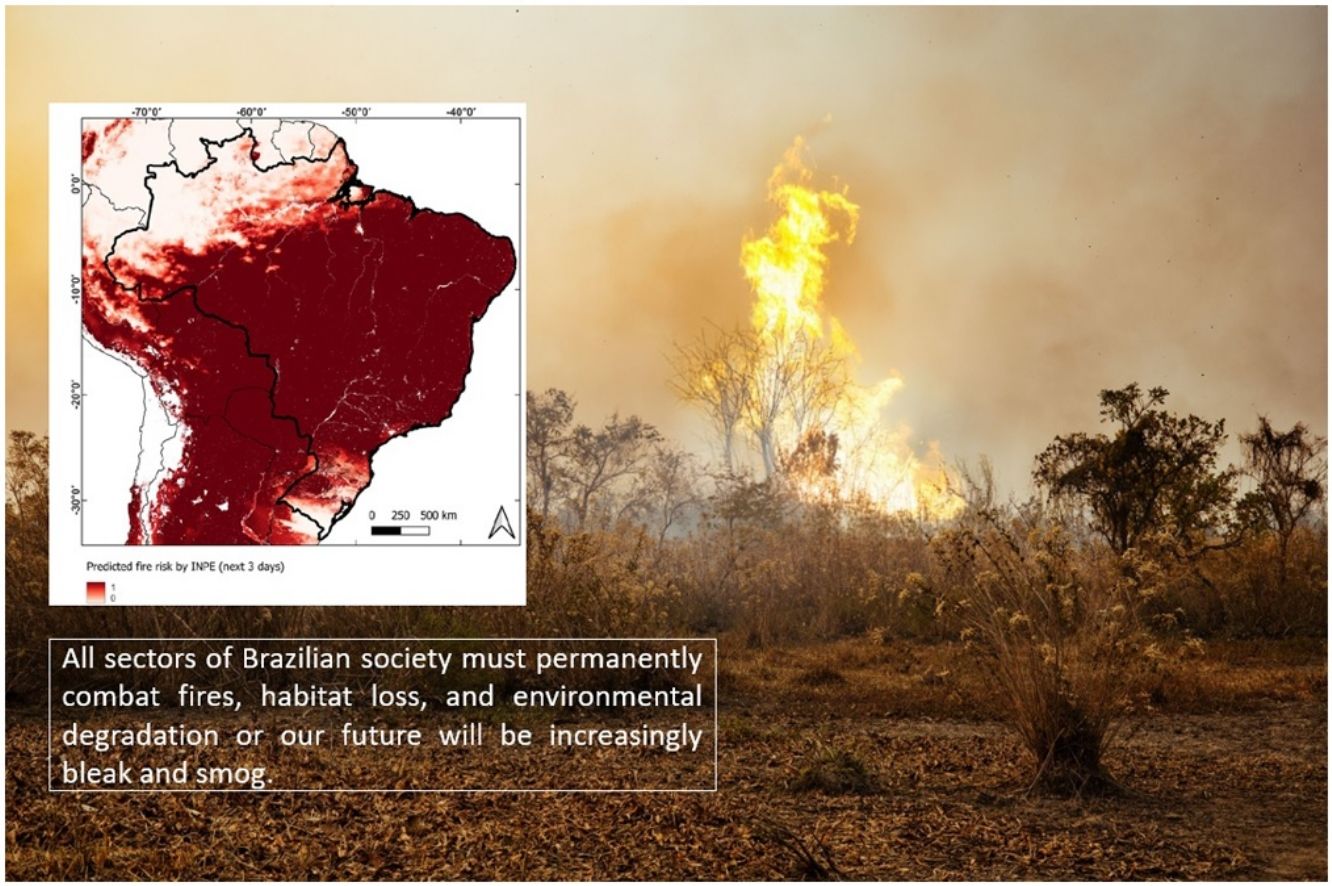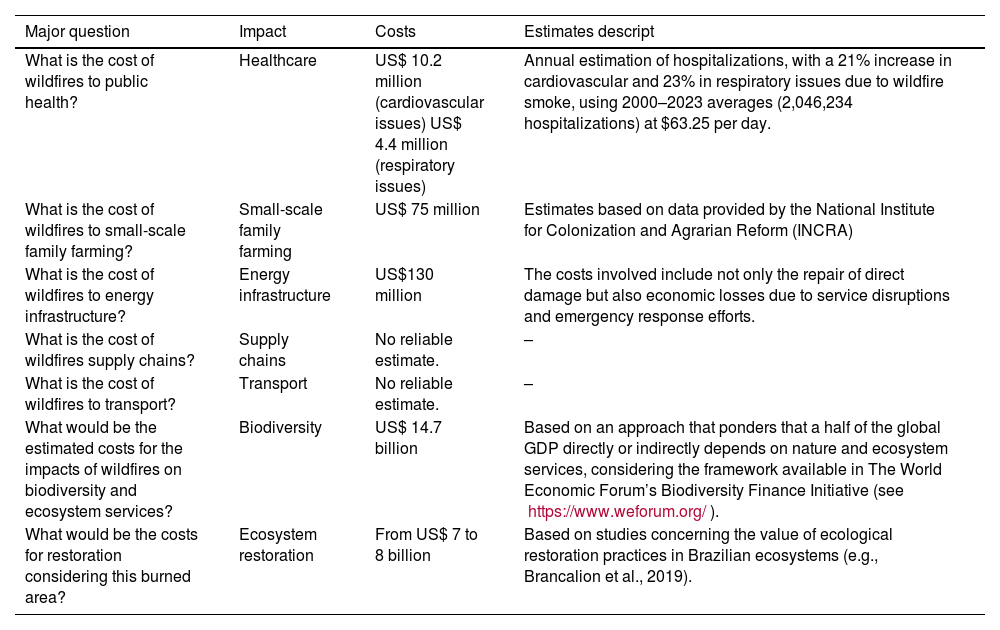Rampant wildfires in Brazil are imposing severe biodiversity declines, incrementing public health problems, and negatively affecting the nationwide economy. Influenced by political interests, wildfires have far-reaching impacts on small-scale farming, essential services, and ecosystems. Hospital admissions for respiratory and cardiovascular issues increased due to smoke exposure, overburdening the health system. Moreover, wildfires contribute to long-term biodiversity loss, degrading natural habitats and disrupting ecological functions and ecosystem services. We probe a critical question: What are the costs of Brazil's wildfires? We foster a discussion of a comprehensive approach to assessing the financial toll across sectors of the national economy, guiding data-driven strategies for mitigation and environmental restoration.
The alarming increases in deforestation and wildfires in Brazil poses a widespread threat to global climate, human livelihoods, public health and biodiversity. These severe disturbances are highly influenced by political aspects, including the Brazilian National Congress being controlled by the ruralist voting in blocks to represent large landholders, mining, logging, hydroelectric dams, and fossil fuels interests (Fearnside, 2023; Vilani et al., 2023). Our critical work aims to analyze the multifaceted impacts of rampant wildfires in Brazil, focusing on their severe consequences for human livelihood, public health and biodiversity. Against the overwhelming increases of nationwide wildfires, the estimations of the total budget to the Brazilian public and private sectors are still unmeasured. For instance, wildfires have important economic impacts that negatively affect several sectors, including small-scale family farming, which only receives 16% of the Brazilian government agricultural plan. These fires also affect public health, environment, and essential services such as energy and telecommunications (Baylis and Boomhower, 2019). Energy companies estimate damage amounting to US$ 130 million in 2024 due to the nationwide wildfires (Enel Green Power, 2024). Wildfires also may cause long-term effects on soil fertility, disruptions in supply chains (Boustan et al., 2020), transport, and aviation.
The pervasive wildfires acutely affect the public health systems, overexploiting an already weakened system. Although most studies on the health effects of wildfire smoke were conducted in the United States, Canada, and Australia (Matz et al., 2020; Borchers-Arriagada et al., 2021) whereas in Brazil, research has predominantly focused on the Amazon region. However, the impact of smoke derived from wildfires (Fig. 1A and B) extends far beyond the Amazon biome, with plumes carried to > 3,000 kilometers and therefore affecting the entire country, including other countries of South America (Fig. 1C). The primary concern lies in fine particulate matter (PM 2.5) in the smoke, which has significant health implications. Furthermore, the toxic and carcinogenic compounds pose a great risk for urban and rural communities, including traditional peoples. The implications of climate change associated with wildfires, and future projections represent an unacceptably high and potentially catastrophic risk to human health, mainly for the most vulnerable groups, such as the elderly, children, pregnant women, and people with chronic illnesses, that in many cases can lead to death.
Maps of wildfire area (A), risk (B) and smoke plume due to forest fires (C) for the year 2024 throughout Brazil and neighborhood countries in South America. Source: National Institute for Space Research (INPE, 2024).
Wildfires therefore hamper access to health services, increase the costs (Requia et al., 2021) and exacerbate medical assistance disparities. The risk of hospitalization due to smoke exposure varies across Brazil (Table 1), depending on the duration and frequency of exposure, as well as the concentration and toxicity of the air pollutants. Rocha and Sant’Anna (2022) estimated that an increase of one standard deviation in PM2.5 concentrations are related to an increase of 1.5% of the monthly average rate in hospital admissions for respiratory conditions, and children and the elderly are hit the most. It is estimated that exposure increases hospital admissions by 21% for cardiovascular conditions and 23% for respiratory issues (Requia et al., 2021). From 2020 to 2023, a mean of 1.5 million people was hospitalized annually for circulatory diseases, and 2.1 million due to respiratory issues. Considering these values and the estimations mentioned above, hospitalizations may amount to approximately 2,149 cases per day. In Brazil each day of hospitalization costs U$ 65.02 which arises an additional question: How much would the additional cost considering a health system overheated? Regarding each age range, length of stay, and different regions of the country, for instance. While health care systems shoulder the burden of caring for individuals affected by smoke and very high temperatures, acting to reduce and mitigate fire exposure emissions evidently improves human health from the direct and indirect impacts of air pollution and climate change. Moreover, in addition to public health costs, for long time Brazil is investing in fire management to reduce the focus, where programs in the Amazon and Cerrado by public agencies such as Chico Mendes Institute for Biodiversity Conservation (ICMBio) heavily invested in human and operational resources for direct firefighting, increasing the costs of the impact of the wildfires (de Mendonça et al., 2004).
Estimates of economic losses caused by wildfires throughout Brazil from January to August of 2024.
| Major question | Impact | Costs | Estimates descript | |
|---|---|---|---|---|
| What is the cost of wildfires to public health? | Healthcare | US$ 10.2 million (cardiovascular issues) US$ 4.4 million (respiratory issues) | Annual estimation of hospitalizations, with a 21% increase in cardiovascular and 23% in respiratory issues due to wildfire smoke, using 2000–2023 averages (2,046,234 hospitalizations) at $63.25 per day. | |
| What is the cost of wildfires to small-scale family farming? | Small-scale family farming | US$ 75 million | Estimates based on data provided by the National Institute for Colonization and Agrarian Reform (INCRA) | |
| What is the cost of wildfires to energy infrastructure? | Energy infrastructure | US$130 million | The costs involved include not only the repair of direct damage but also economic losses due to service disruptions and emergency response efforts. | |
| What is the cost of wildfires supply chains? | Supply chains | No reliable estimate. | – | |
| What is the cost of wildfires to transport? | Transport | No reliable estimate. | – | |
| What would be the estimated costs for the impacts of wildfires on biodiversity and ecosystem services? | Biodiversity | US$ 14.7 billion | Based on an approach that ponders that a half of the global GDP directly or indirectly depends on nature and ecosystem services, considering the framework available in The World Economic Forum’s Biodiversity Finance Initiative (see https://www.weforum.org/). | |
| What would be the costs for restoration considering this burned area? | Ecosystem restoration | From US$ 7 to 8 billion | Based on studies concerning the value of ecological restoration practices in Brazilian ecosystems (e.g., Brancalion et al., 2019). | |
Pollution costs are not limited to the direct impact on the public health system. The costs associated with production losses due to cardiorespiratory diseases tend to overcome hospitalization costs at a considerable rate. Even though the most affected are children and senior people, adults in the working force (usually women) have to stay at home to take care of the sick. Moreover, wildfires increase greenhouse gas emissions (GHG) in Brazil. Assuming that 2024 will expand 2022 GHG emissions by a factor of 25% (a very conservative hypothesis), this would represent an increment of 29.9 Million tCO2eq. Considering the current price in the European Union Emission Trading System as a proxy of the social cost of GHG emissions (US$ 72.5/tCO2eq), the expansion of wildfires in 2024 could represent an additional global carbon emissions cost of US$ 2.2 billion.
Furthermore, wildfires act as a driving force behind the rampant degradation of biodiversity, contributing to widespread native biotas loss. Considering the wide gamma of taxon affected by the wildfires — given that Brazil host a myriad of known and unknown species — and the vast and controversy literature to value financially the biodiversity (e.g., Mountford and Keppler, 1999; Salles, 2011; Small et al., 2017), another question emerges: What would be the estimated costs for the impacts of wildfires on biodiversity and ecosystem services? The immediate financial impacts of big-fires on biodiversity during 2024 (from January to August) can reach US$ 1.8 billion per month (US$ 14.7 billion in total; Table 1). This simple estimate was based on an approach that ponders that a half of the global GDP directly or indirectly depends on nature and ecosystem services, considering the framework available in The World Economic Forum’s Biodiversity Finance Initiative (see https://www.weforum.org/). To do so, we used as baseline the total Brazilian GDP in 2023 (US$ 2.2 trillion) equally distributed across the nationwide territory (8.51 million km2), representing uniformly US$ 228.5 per km2. Given that until August-2024 165,574 fire spots were recorded throughout Brazil (INPE, 2024) and considering that only 10% of these spots are big-fires, the total area burned can reaches 113,960 km2 (∼1.5 % of Brazilian territory) and US$ 129.3 per km2 depends on biodiversity and its services, this estimates represents the aforementioned value of US$ 14.7 billion 2024. We recognized that these values can be contradictory or underestimated, for instance the estimated global value of crop pollination services can range from US$195 billion to approximately US$387 billion per year (between US$267 billion and US$657 billion; Porto et al., 2020).
Another way to access the values of environmental degradation is by estimating the cost of restoring natural systems affected by fire. According to the MapBiomas platform (https://brasil.mapbiomas.org/), the total burned area amounted to 113,960 km2, being 18,730 km2 of forest formations were affected in 2024, marking a significant increase of 304% compared to the same period in 2023. Thus, based on studies concerning the value of ecological restoration practices in Brazilian ecosystems (Brancalion et al., 2019) we reiterate: What would be the costs for restoration considering this burned area? Based on studies concerning the value of ecological restoration practices in Brazilian ecosystems (e.g., Brancalion et al., 2019), we estimate the restoration cost for the area burned in 2024 to be between US$ 7.0 and US$ 8.0 billion, depending on the extent of natural regeneration in the affected areas (Table 1).
We argue that the impacts on biodiversity and natural habitat spread in a long-term cascade effect throughout the ecosystem services (e.g., ecotourism, pollination, seed dispersal and insect pest control) and environmental recovery. The chronic and long-term financial effects of wildfires on ecosystem services, ecosystems functioning, ecological functions and environmental recovery should be incalculable against our limitations and controversies to value biodiversity aspects. Yet, the unprecedented phenomena of wildfires observed in the last 5-years lead to a burning of 12,48% of Brazilian territory (∼1 million km2), sometimes reaching areas where the biodiversity was not totally depicted due to glaring knowledge gaps. Therefore, it is paramount to recognize that a significant portion of the losses caused by the wildfires cannot be measured financially due to the intrinsic values of nature elements. Many of the affected species perform irreplaceable ecological functions, such as maintaining ecosystem balance and providing cultural ecosystem services, including the aesthetic, spiritual, and recreational value of the habitats they inhabit. This represent a remarkable magnitude, given that the wildfires only in the Pantanal wetlands during 2020 killed 17 million vertebrates (Tomas et al., 2021). The Environmental Public Prosecution Office of the Mato Grosso do Sul State provides estimates to the cost of rehabilitation and disposal of wild animals affected by fires (MPMS, 2018). These costs vary according to the species, ranging from US$ 412 (for some birds) up to US$ 2,850 (jaguar) and US$ 4,272 (giant otter) per animal. Thus, assuming a conservative estimate of US$ 1,000 per animal, these animal losses and its ecological functions is not less than US$ 17 billion.
Our major questions therefore indicate the areas that should be calculated to estimate the financial impact of the wildfire in the whole country mainly regarding the human livelihood, health care system and the biodiversity loss (Table 1). We also argue that many other economic sectors must be interrogated as well to give a proper budget of the impact. It is important to note that there was an increase of more than 400% in the amount allocated by the Brazilian Federal Government for firefighting during the eight months of 2024 compared to the entire year of 2022. These amounts generally involve the cost of inspection, investigation, material and equipment, and firefighters. However, it is also necessary to consider that part of the cost of fighting fires is borne by Non-Governmental Organizations and individuals who end up allocating their own resources to contribute to these firefighting actions and to care for poisoned or injured animals, in addition to putting their health and safety at risk to prevent the spread of fire on their properties, livestock, and wildlife. Finally, we fully recognize that to do so the estimations, it needs to be based on available and robust data, which are in many cases, incipient, requiring approximations. Moreover, it is necessary to consider the intrinsic and invaluable value of biodiversity, making it more robust and reaching the Development Sustainable Goals.
Yet, considering the current scenario of wildfires in Brazil it’s possible to reach high values for the estimations, due to the severely affect to the public health and human well-being, small scale familiar agriculture, communication and energy, education, transport, ecotourism, biodiversity, ecosystem services, and several other sectors, which also needs to consider the synergistic and cascade effects. So, our estimates, though preliminary, highlight the urgent need for in-depth studies to accurately quantify the costs of Brazilian wildfires and inform effective public policies for fire prevention and mitigation. We strongly recommend that further long-term studies can evaluate the financial impacts of wildfires globally. This threat is far from over, leading to severe environmental and economic uncertainties. The continuous destruction of ecosystems due to wildfires not only disrupts biodiversity and ecological functions but also exacerbates long-term socio-economic vulnerabilities.
Despite the widespread environmental degradation occurring across various regions of the Global South, international attention and funding for fire prevention, mitigation, and recovery efforts remain disproportionately focused on rich regions of the Northern Hemisphere. Critical southern biomes, such as the Amazon, Cerrado, Pantanal, and Chaco, that suffer from similar or even worse degradation, yet receive significantly less global recognition and investment. This lack of prioritization in emergency agendas deepens existing inequalities, limiting resources for conservation, sustainable land management, and adaptation strategies. Consequently, these regions face escalating risks of habitat loss, declining ecosystem services, and worsening climate impacts, which ultimately affect local communities and global environmental stability, distancing us further from the Millennium Development Goals and international environmental agreements, to which approximately 85% of the world's countries are signatories. The fall of great civilizations has always been due to conflicts and neglecting the finiteness of natural elements, but this has never happened so rapidly and on a global scale. Therefore, despite still lacking precise answers, our questions indicate that all sectors of Brazilian society must be permanently combating fires, habitat loss and environmental degradation, or our future will be increasingly bleak and smog.
CRediT authorship contribution statementConceptualization: ES, WLL, BDV, JAB.
Writing – original draft: ES, WLL, BDV, AVBdaF, CEFY, DVSC, CRSV, EdeO, LLR, ARdeS, DJdaS, EI, SH, ARAI, CCM, MdosSF, JAB.
Writing – review & editing: ES, WLL, BDV, AVBdaF, JAB.
The authors declare no competing interests.








